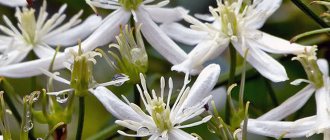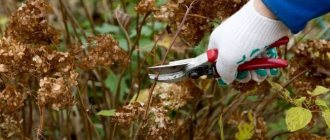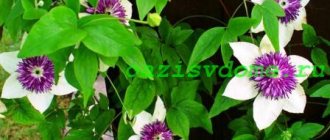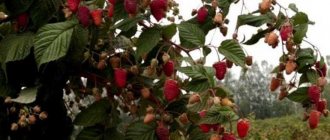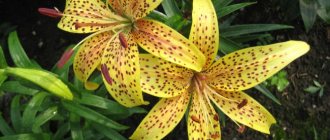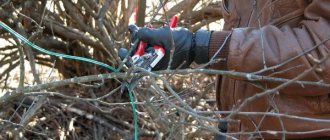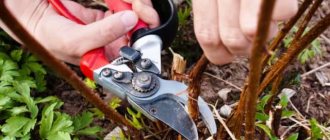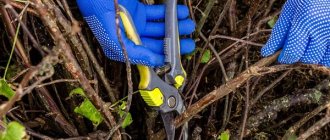How to do something yourself, with your own hands - home craftsman website
AN EXCELLENT TOOL FOR CRAFTERS AND HANDCRAFTS AND EVERYTHING FOR THE GARDEN, HOME AND Cottage LITERALLY FOR FREE - SEE FOR YOURSELF. THERE ARE REVIEWS.
DRY AUTUMN IS NOT RARE IN RECENT YEARS. AND IF IT WAS POSSIBLE TO LIVE QUIETLY WITHOUT AUTUMN WATERING, THE PLANTS WERE SATISFIED WITH WHAT “DRIPPED FROM THE SKY,” NOW YOU CAN’T DO WITHOUT ADDITIONAL WATERING BEFORE WINTERING. LET'S TALK ABOUT HOW IMPORTANT THIS IS, AND ALSO ABOUT WHEN TO WATER, WHAT AND IN WHAT QUANTITY
First, let's figure out what it is - moisture-recharging irrigation
. This is not some kind of terrible beast, but just abundant late-autumn watering. Some are for it, some are against it.
General requirements for fertilizing conifers
Many amateur gardeners are interested in how and what to feed conifers. Some are of the opinion that they do not need fertilizer at all, because most coniferous plants grow in forest thickets and no one takes care of them. And they grow for a very long time. But experienced gardeners strongly advise feeding plants to prevent diseases. It is especially important to fertilize young plants that have weak root systems.
You may be interested in: Preparation Maxim, instructions for treating soil and planting material
2.Retains heat in the soil
How it works? It’s very simple: the heat capacity of wet soil is higher than dry soil. That is why, if the soil has been moistened since autumn, it retains heat much longer, freezes more slowly and also slowly and gradually thaws. It is in this “mode” during winter thaws (which are not uncommon in central Russia, and in other regions of our country for a long time) that temperature fluctuations will be smoother. And all this allows the plant to survive the winter much more comfortably.
Saves from winter dryness
Why do rhododendrons and conifers burn so badly in the spring, why do fruit trees come out of winter so weak?
The answer is that all this is due to the drying out of the soil, and not at all from frost. Despite the fact that in winter the roots do not work in frozen soil, moisture from the plants still evaporates through the bark.
The intensity, of course, is very small, but new water does not enter the plant, there is no replenishment, and over the long, long winter the loss is significant. It evaporates especially strongly at the end of winter - beginning of spring, when the sun
starts to get hot. And it is precisely our autumn moisture-recharging irrigation that helps saturate the soil layers with moisture at a depth of up to 2 m (depending on how much you water), where soil cooling occurs much more slowly. This will at least to some extent help the plants compensate for the loss of moisture.
Autumn watering also solves the problem of spring lack of moisture. It often happens that snow can melt very sharply (it’s hard to remember the last time it melted slowly and evenly), in this case the melt water is poorly absorbed into the soil, flows off, since the ground is still frozen, it does not keep up with the rapidly melting snow . Another option for the development of the winter-spring “scenario” is a small amount of snow, which is not enough to saturate the plants normally with moisture in the spring.
And as a result, we observe a later appearance of leaves, weaker and also later flowering. In general, plants lag behind in development. You have to actively water the plants with water (preferably warm) in March-April, when there is already a lot to do in the garden. Why add more spring troubles to yourself if you can do everything without haste in the fall?
Mulching
To avoid freezing of the root system when there are frosts in the yard, but there is no snow, in the fall it is necessary to spread mulch around the crown up to 7 cm thick. Mulching is an extremely necessary measure especially for newly planted and “foreign” coniferous seedlings, which have not yet had time to adapt to new ground for myself. Mulch also includes sawdust, peat, mowed grass, fallen pine needles, collected exclusively under healthy evergreen trees. With the arrival of spring, the mulch is removed so that the soil begins to warm up.
Place mulch around each young seedling to prevent the roots from freezing
How much to water?
Get ready: you need a lot of water. You can’t do it with just a bucket - you’ll only “spit” lightly on the soil, and you won’t even be able to wet the top layer. Our task is to saturate the deep layers with moisture. So, if you have ordinary medium-sized loams (characteristic of our region), normally drained and with an average level of groundwater, in order to achieve the desired effect, you need to pour 100 liters (!) of water per square meter. And this is an average figure that will vary depending on what plant you are watering. For example, for a young, freshly planted tree, 50 liters are enough, while for an old tree - 150 - 200 liters. Also, the amount depends on the weather; if it’s dry in the fall, we water more, if it’s wet, less.
Treatment against diseases and pests
When preparing conifers for winter, gardeners ask themselves the question: how to properly protect and prevent planted evergreen trees from diseases and pests. In any case, whether the plant is healthy or you notice yellowed needles, it is necessary to carry out a number of preventive works and spray with special means to avoid unpleasant consequences.
Removing yellowed branches
- Using pruning shears, remove dry and broken branches. If you are cleaning thujas, remove all yellowed needles between each branch. This difficult manipulation will save your thujas from death, since by removing all the bad needles from the trunk, the branches will be able to turn green.
- Postpone formative pruning of plants, if done in the spring.
- To prevent fungal diseases and mold, prepare a 0.5% - 1% solution of copper sulfate (60 g - 100 g of powder diluted in 10 liters of warm water, in a plastic bucket!) or use Fitosporin, following the instructions, and spray coniferous crops . We process in clear weather at a temperature not lower than + 5 degrees.
- After two weeks, for preventive purposes, we recommend treating the plants with an insecticide against insect pests.
HOW AND WHAT?
Even watering should be done differently on different soils. If you have heavy soil that does not actively allow water to pass through, then it makes sense to make several wells around the perimeter of the crown - they should be about a meter deep - and water into them.
If the soil is light and absorbs moisture well, then everything is simple: place the hose under the crown and just move it around the crown from place to place, so that the entire area is saturated with water. You just don’t need to pour it under the barrel.
If you have sandy soil, where water drains away very quickly, soaking only a very small area, use sprinkling in this case.
IS MOISTURE-CHARGING IRRIGATION HARMFUL?
Water-recharging irrigation is beneficial for most plants, but there are a number of crops for which this activity is more likely to harm than benefit. Among them are some stone fruits - cherry plum, apricot, Ussuri plum, felt cherry. Excessive soil moisture can lead to overheating of the root collar.
You should not overuse such abundant watering if your garden has heavy clay or loamy soil with a high groundwater level.
You can water from a watering can, but then you will have to run from the barrel to the tree many times - it is better to use a hose.
And in the latter case, to avoid overwatering, first determine the watering time. This is easy to do: just put the hose in a bucket of water, time the time it takes for it to fill, and calculate how many minutes it will take to water the plant with the right amount of water.
If the summer turns out to be extremely hot and dry, and the plants, despite constant watering, still look “tormented” and stunted, it makes sense to wait for the leaves to fall, otherwise watering may provoke plant growth.
© Author: MARIA DAVYDOVA, experienced gardener
We'll feed you and give you something to drink
Preparations begin at the end of summer. The first thing you should take care of is feeding. From August, nitrogen should be completely eliminated, focusing on phosphorus-potassium fertilizers. This will speed up the ripening of new growth, increase the stability of the root system and have a general strengthening effect. After the leaves of deciduous plants have completely fallen off, begin moisture-charging watering. This is a prerequisite for a favorable wintering of conifers. The diameter of the irrigation circle must be no less than the diameter of the crown. Moreover, the younger the plants, the more important it is for them to water, since their roots have not yet gained sufficient strength and can be seriously damaged when the soil freezes. Increased soil moisture will prevent this.
It is recommended to mulch the tree trunk circles; this will help protect the root system from frost. In this case, the mulch layer should be at least 5 centimeters, quite loose. In early spring, it is necessary to remove the mulch to prevent the roots from getting warm.
MOISTURE-CHARGING IRRIGATION IS A MANDATORY AGROTECHNICAL PRACTICE
After harvesting, several agrotechnical measures are carried out in the orchard, which are very important for the life and fruiting of fruit and berry plants. Including autumn or pre-winter moisture-charging watering . This agricultural technique helps trees and shrubs safely go into a dormant state and survive the winter.
Pre-winter watering is carried out as late as possible, after leaf fall, but approximately a week before the onset of the first frost.
To do this, it is advisable to rely on meteorologists’ forecasts: as soon as they announce that the temperature is expected to drop to 0 °C in the coming days, it’s time to go out into the garden. You need to have time to water all the trees before the soil begins to freeze. But at the same time, the average daily air temperature on watering days should be only slightly above zero - within 1-2 °C. If moisture-charging watering is carried out earlier, while it is still warm enough, the influx of moisture to the roots can provoke rapid growth of trees or swelling of the buds. And plants should not go to winter in an active state.
Moisture-charging irrigation is a mandatory agrotechnical practice. Many not very experienced owners of household plots believe that if the autumn is rainy, with a lot of precipitation, then watering can be neglected. But even frequent and heavy rains are not always able to completely wet the root layer of soil - this is the task of the gardener.
As a rule, such irrigation requires a lot of water. But you can’t overfill it either—the soil must maintain a balance of moisture and air. When there is excess water, it displaces most of the air, causing the root system of the plant to begin to suffocate and rot.
Sometimes water-charging irrigation is contraindicated - in cases where excess water forms in the soil for a long time, which can harm the plants. For example, you cannot water trees if the garden is located on heavy clay soils that retain moisture for a very long time, or is located in lowlands with high groundwater levels.
To understand how much watering is necessary in a particular case, take a soil sample for moisture capacity.
Features for plants
All conifers require their own autumn treatment: some will not survive the winter without abundant watering, others without feeding, and others without shelter. Indeed, despite all the similarities in care, there are also significant differences.
For pine
Before the first frost, the root system of newly planted trees is covered with a layer of peat (8-9 cm). In this case, peat plays the role of mulch, which will protect from frost and prevent moisture loss. In some regions, young pines are also covered with spruce branches to prevent frostbite on the crown. It will also save plants from sunburn at the very beginning of spring.
It is generally accepted that an adult conifer does not need feeding at all. In the forest it is humus from fallen leaves, and in the plots it is rotted compost. When embedding it in the ground along the tree trunk, it should be taken into account that the pine rhizomes are located close to the surface - they can easily be damaged.
Mineral fertilizers for pine are used once a year, just like organic ones. They are usually spread over different periods: if compost is added in the fall, then the mineral complex is put aside until spring. Or vice versa. There is no fundamental difference here. However, some gardeners are categorical on this issue, preferring to apply mineral fertilizers exclusively in the spring. Usually they are not even bred, but simply scattered around the tree and watered abundantly.
For spruce
Spruce also needs preparation for winter. But, in addition to peat, the tree trunks can be covered with non-woven fabric or kraft paper.
Adult plants do not need feeding if there are no external signs of starvation. After all, they practically do not grow until they are 6 years old, and therefore consume few nutrients. Special growth stimulants are suitable for them, as well as complex formulations, which are recommended to be used no more than 1-2 times a year.
Spruce needs feeding after 7 years, when the tree begins to grow up to 0.5 m per year. If a forest spruce grows on the site, and not an ornamental (dwarf) one, you should not overfeed it, so as not to spoil the entire landscape design. Gardeners note that with poor nutrition, such spruce trees grow for no more than 3 years, then a beautiful, fluffy crown begins to form.
Processing conifers in the fall, preparing trees for winter
There is an opinion that conifers are unpretentious plants, and therefore tolerate even harsh Russian winters well. However, they also require good care, protection from diseases and proper processing in the autumn. Then coniferous plants will delight their owners for many years with their beauty and the enchanting smell of resin.
Preparing for winter
It is necessary to prepare conifers for the cold season in advance. In the fall, they are thoroughly watered (up to 9 buckets for each plant), young trees are mulched with tree bark, and fertilizers are applied. Some gardeners prefer to feed conifers in the fall with rotted compost (cover the plants with a layer of 5 cm), others use special purchased fertilizers.
Trimmed conifers are covered for the winter. This is done after abundant watering and fertilizing. During the cold season, plants will not be able to receive adequate nutrition, and therefore they must make the necessary reserves in the fall. The main thing is to follow the dosage and not “overfeed” the coniferous trees.
Note. If you apply too much fertilizer in the fall, the plant will begin to grow rapidly and will not be able to prepare for winter. The result can be disastrous - the conifer will freeze.
These trees really need magnesium. It is this element that is responsible for the integrity of the needles. With a deficiency of magnesium, the needles turn brown, dry out and fall off. This is most pronounced during the dry period. To compensate for the deficiency of this microelement, it is better to use liquid mineral complexes specifically designed for coniferous trees.
Work time
Preparations for winter begin from the very beginning of autumn. Conifers are treated against diseases and pests, if necessary, they are mulched, watered, and weeds are removed. If we talk about fertilizing, it is usually applied twice: in May (during the period of active growth and development) and in August-September.
If you are late with the autumn application of fertilizers, then the young conifers will simply have a nutritional deficiency. After all, they will spend a lot of effort on rooting. Hungry trees find it more difficult to survive in winter and are more likely to die.
If you plan to use liquid formulations, you should strictly follow the instructions. A highly concentrated solution will destroy the root system. To apply fertilizing, dig a shallow circular groove. The nutritional composition is poured there.
If granular fertilizer is used, do not leave it on the surface. It should be embedded in the soil. In parallel with fertilizer, dolomite flour is often added, which not only deoxidizes the soil, but also supplies it with a number of microelements.
Fertilizers and fertilizers
Coniferous trees need adequate nutrition, but not all fertilizers are equally beneficial for them.
Rules for choosing fertilizing
- Fertilizer for conifers should contain a minimum of nitrogen.
- Magnesium in the supplement should be in an easily digestible form.
- A large number of microelements will only benefit plants.
When choosing a nutrient preparation, you must be guided by the given rules, because an incorrectly selected fertilizer will only cause harm. Gardeners advise that it is better to skip fertilizing than to destroy the plant by wrong actions.
It is enough to feed conifers twice a year: in spring and autumn. The second feeding is designed to prepare the plants for the cold period and assist in the maturation of growth over the past year.
It is especially important to apply fertilizers to young conifers, whose root system is not yet strong enough and is not able to independently extract food from the soil.
Organic
Conifers should not be overfed with organic matter for the winter. In young plants, excess nutrients can cause burns. In addition, autumn overfeeding will disrupt the process of preparing plants for the dormant period.
Growing pine: planting
Pine planting time
In general, it is better to plant not only Scots pine, but also many other conifers either in the spring (at the very end of April and the beginning of May) or in the fall (at the end of September and until the beginning of October). If you plant a Scots pine on a plot in late autumn, there is a risk that it will not be able to quickly adapt to the plot and, therefore, be ready for winter, and the seedling may die.
Choosing a pine seedling
As for Scots pine in particular, and most conifers in general, when choosing planting material for these crops, you should focus exclusively on purchasing seedlings with a closed root system, that is, placed in a container.
The advantages of such seedlings are very significant: a perfectly developing root system that was not tormented by transplants, a solid lump of soil from the container in which the root system is enclosed - all this will allow plants to be planted on the site without problems, as well as beneficial microorganisms that are in symbiosis with Scots pine, which are stored on the root system of seedlings placed in containers.
If, when buying pine seedlings, the roots of which are wrapped in ordinary burlap or bags, you are assured that the bacteria on the roots are alive, do not believe such sellers. The fact is that these beneficial bacteria die after a maximum of a quarter of an hour in the open air. For the same reason, when transferring from a container to a planting hole, you should not hesitate; the seedling should be immersed in the soil as soon as possible after being removed from the container, which is why it is important to dig planting holes in advance when planting Scots pine from a closed root system.
However, you should not think that if the bacteria die, the seedling will be finished; in fact, this is not entirely true; a Scots pine seedling can be planted in the soil even after it has lain with its root system open for more than a quarter of an hour, but in this case the risk that the seedling will not take root in the new location will be higher.
In addition, when choosing a pine seedling in a nursery, do not chase after its large size, firstly, it is significantly expensive (from $1000 and above), and secondly, the older the seedling, the greater the risk that it will not take root in the new place , will be significantly higher. Pay attention to five-year-old pine seedlings; they cost half as much and take root ten times better.
Scots pine "Fastigiata" (Pinus sylvestris 'Fastigiata'). © RosBum
Scots pine "Watereri" (Pinus sylvestris 'Watereri'). © Lubera
Scots pine "Albyns" (Pinus sylvestris 'Albyns'). © Oriental Garden Supply
Pine planting site
Scots pine will grow remarkably and develop steadily in a well-lit area, but it will also feel quite good in sparse shade. If the Scots pine is planted in full shade, then it will develop much worse there; it may grow one-sided or twisted, because its shoots will literally stretch towards the light.
Once the location has been chosen, you need to start making the planting hole. The size of the hole for a pine tree can be a couple of centimeters wider and deeper than the container, so that drainage and nutritious soil can be added to the walls and base.
When planting, try to choose a place for Scots pine without stagnant melt or rain water, because this plant does not tolerate excess moisture. Since we remembered about drainage, be sure to lay it at the bottom of the hole 4-6 cm thick, it can be pebbles, broken bricks or expanded clay, it doesn’t matter.
On top of the drainage layer you need to put a nutrient layer of soil, which should consist of a mixture of nutritious soil, flavored with turf soil, river sand and humus in equal parts with the addition of a teaspoon of nitroammophoska. This composition must be mixed thoroughly and laid in a thin layer (2 cm is the maximum) on the drainage layer.
Planting a pine tree
Next, you need to very carefully, so as not to destroy the earthen ball, cut the container and install the earthen ball with a pine seedling in the prepared hole. The key to success here is the installation of the seedling in the hole without affecting the earthen ball.
When planting Scots pine, try to place it in a hole so that the root collar of the pine eventually, even after the soil settles, is at the level of the soil surface; therefore, after planting, the soil must be thoroughly compacted so that even if soil settlement occurs, it will be minimal . On loose soils, which can settle noticeably over time, Scots pine seedlings should be planted so that the root collar is even slightly above the soil surface; There is no need to worry: in a month it (the neck) will be exactly equal to the ground.
After final planting, the pine seedling needs to be watered with a bucket of water at room temperature and the surface mulched with peat or humus with a layer of a couple of centimeters in order to conserve moisture in the soil. When watering, you can not only moisten the soil, but also spray the crown with a spray bottle; do not forget that conifers really like to “bathe”.
Watering and pruning evergreens, diseases of conifers (We will grow the fence ourselves - 4)
Tying. Plants need to be tied up at the planting stage, and not when it tilts or is torn out of the ground in a strong wind. Usually the seedling is tied to a stake, which is driven into the soil near the trunk. However, this method is not recommended for plants grown in a container, because it will disrupt the integrity of the earthen ball. It is better to tie a plant from a container to a peg installed at an angle.
However, this method is not suitable for those trees that have stems with leafy branches densely flattened over the entire height. In this case, it is recommended to tie the plant to three pegs, placing cuttings of a garden hose under the ropes so as not to injure the stems.
Recommendations: to prevent the plant from falling, tie it to a reliable support before planting, do not remove the packaging until planting. Make sure that the earthen ball is wet all the time. If planting is delayed too long, cover the ball with moist peat, compost or soil.
When preparing for mass plantings of large trees, it is necessary to comply with certain requirements of the technology developed for this. Trial plantings of different breeds revealed one of the bottlenecks in the system of post-transplant adaptation. The main reason for the death of transplanted large trees was a severe metabolic disorder.
It is caused by a weakening of the normal synthesis of hormones and complex organic substances naturally synthesized by the plant that have regulatory functions. The vital functions of the root system and the crown of a tree are closely interconnected. In the shoots of the crown, hormones are synthesized that stimulate the vital activity of the roots.
In turn, hormones are synthesized in the roots, which have a beneficial effect on ground organs.
Even if the tree is transplanted with the utmost care, a significant part of the most active roots is lost. Transplantation leads to disruption of water metabolism and reduced absorption of nutrients. However, the main problem of plants that have changed their “place of residence” is the weakening of their basic biosynthetic functions. As a result, the root system does not provide the necessary hormones to the above-ground part of the tree, which, in turn, cannot receive the required amounts of hormones through a descending flow of substances. This can be avoided by providing the plant with the required amount of hormones.
Pruning Evergreens
Pruning of such plants is carried out taking into account their species. Evergreens require little to no annual pruning. The exception is plants planted as a living fence. But evergreens sometimes need a light pruning. Branches 1-1.5 cm thick are cut with pruning shears. To trim branches 1-3.5 cm thick, special scissors with long handles are used. Plants are usually trimmed with garden shears or special scissors for trimming a living fence. Carefully remove the ends of plant branches: this stimulates the growth of buds located below the cut
It often happens that one or more branches on an evergreen plant grow longer than the others and protrude beyond the crown. Such a branch is cut down to the base; simply cutting off the tips of the branches is not enough. Sooner or later, most or all of the branches will stretch and need pruning.
Some of the largest branches can be removed, and later a similar procedure can be repeated annually; If all branches are severely shortened at the same time, the plant may die. Many conifers can be trimmed, but trimmed plants tend to take on an unnatural appearance.
To limit the growth of an evergreen plant that grows too quickly, several vertical cuts to the depth of a shovel are made around the circumference of the crown in the soil.
Timing of pruning. Almost all evergreens are pruned in the spring; the best time for this is March-April. Do not rush to cut out branches damaged in winter; wait until the end of spring to assess the actual extent of the damage and see if new growth appears on the branch. Evergreen shrubs that bloom in spring are pruned immediately after flowering. The worst time to prune evergreens is August–October.
Watering evergreens
Evergreens need the same care as other plants: during the period of active growth they need to be watered, fed, and weeded. Before planting the plant, add a fertile mixture and mulch the surface of the soil under the plant every spring. Mulching is the application of coarse organic matter to the surface of the soil under plants. This operation has many advantages, including the following:
- During summer drought, the soil retains moisture better.
- The soil surface covered with mulch material remains cool on hot summer days, and plant roots grow more actively in such cool and moist soil.
- The number of weeds is reduced; weeds growing through the mulch layer are easily removed.
Some mulching materials provide plants with additional nutrition, resulting in improved soil quality. Wet peat, crushed coniferous tree bark, leaf humus, and well-rotted manure are suitable for mulching. Mulching is usually carried out in May.
Its effectiveness depends on soil preparation. Remove debris and old leaves, water weeds, and water dry soil. If necessary, scatter dry fertilizer and lightly work it into the soil with a hoe. After this, distribute a layer of mulch 5-8 cm thick around the plant so that it does not touch the shoots, otherwise they may die.
Next spring, the mulch layer is renewed.
Evergreens should be watered for two years after planting during dry weather in spring and summer. Rooted plants can be watered less often, but you should not completely deprive them of watering. During drought, pay attention to plants that grow in so-called “risk zones”: near the wall of the house, on sandy soil.
Evergreens with shallow root systems may suffer from lack of moisture during drought, even if they are growing in good soil. Pour 5 liters of water under each small plant, and 20 liters of water under a large plant. You need to water with a gentle stream closer to the base of the plant. The best method of watering is drip irrigation using a perforated hose laid among the bushes.
A roll of soil poured around the plant gives a good effect. When watering, it is convenient to fill the resulting “saucer” with water; it will stay in the soil longer. It is important not to forget to weed the weeds around the plants; this should be done repeatedly throughout the season. Weed growth can be suppressed by adding a layer of mulch material.
In this case, even if they crawl out of the soil, they can be easily removed by hand, while numerous weeds that grow in an uncovered area of soil around evergreens will have to be removed with a hoe.
Diseases of coniferous plants
Conifers, like all living things, are susceptible to various diseases. The first symptom that should alert you is yellowing and browning of individual branches. If the soil does not contain adequate nutrition for the plant, but it produces a large increase in shoots, then it is predisposed to premature yellowing of old branches, since it transfers all the incoming nutrients to young shoots.
Particular harm to plants is caused by numerous pathogenic microorganisms that develop both on the bark and on the needles. Most often these are mushrooms. First the needle turned brown, then a twig, half the plant, and gradually only the top of the pine remained, and the juniper had only one name.

